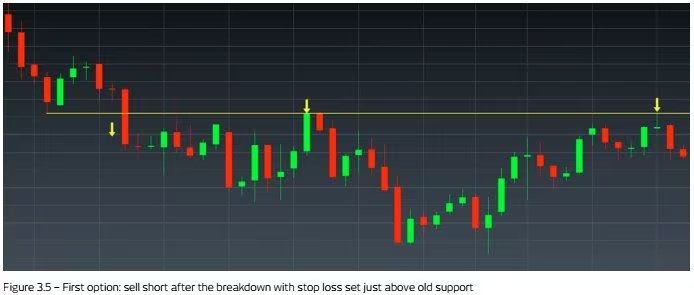A stop-loss aims to cap your losses by closing you out of the trade once your pre-determined figure has been reached. The stop-loss order you’ve set will stay in effect either until it’s triggered, cancelled or your position is liquidated.
If the instrument’s price falls below your threshold, your stake in the instrument will be sold at the next available market price. By occurring automatically once your limit is reached, it provides an exit plan, preventing you from losing any further capital on that position.
This stop-loss level is determined by the trader, who might take into account factors like current underlying market conditions and the likelihood of slippage occurring. Slippage is the difference between the expected price and the actual price the trade was executed at. This can occur at periods of high market volatility, such as major news events, when either entering or exiting the trade.
There are two types of stop-loss orders, depending on your position: a ‘sell’ stop and a ‘buy’ stop. The most commonly used is the sell stop.
What is a sell stop-loss order?
If you’re in a long position, meaning the instrument (such as a specific currency pair, stock or commodity) is being bought with the expectation it will increase in value, you would implement a sell stop-order. The trader, therefore, benefits when the market price rises. The stop-loss order would be set up below the current market price.
What are the timeframes for a stop-loss?
The stop-loss order lasts until either a) the stop-loss level is reached, b) the stop-loss is removed without closing the trade, or c) the trade is closed.
What are the benefits of using a stop-loss?
Some of the benefits of implementing a stop-loss within your trades are:
They are useful if you cannot monitor the market for extended periods of time
They can help manage losses (particularly important when trading on leverage)
There is no cost to attach one
It prevents loss aversion by automatically exiting, rather than holding on to losing trades
Different types of stop-loss orders
There are various types of market orders, aside from the most commonly-used sell stop-loss order:
What is a buy stop-loss order?
If you’re opening a short position you would use a ‘buy’ stop-loss order, as the instrument is being sold with the expectation the price will go down.
What is a trailing stop-loss order?
A trailing stop-loss order, unlike a regular stop-loss, will follow, or ‘trail’, the price of a trade as it fluctuates. The trailing stop is set a percentage, or a specific number of points, away from the current market price, which accommodates for the fluctuation in the asset’s value, as the stop-loss adjusts.
So on a buy trade for example, the trailing stop will rise as the price of the instrument rises, staying a pre-set distance away. If the market then begins to fall, the trailing stop remains at its new higher level. These stops aim to lock in profit by moving in the direction of a winning trade, while ensuring a cap is in place, in case the trade doesn’t go in your favour.
Likewise to a regular stop-loss order, a trailing stop and a buy stop-loss would not guarantee you’ll exit the position on the price you set. If the market gaps or you experience slippage above or below your set stop-loss, your position will be closed at the next available.
To find out more, read our article on trailing stop loss orders.
What is a guaranteed stop-loss order?
If you want complete certainty that a trade will close out at the exact price you set your stop, without running the risk of slippage, you can pay a premium for a guaranteed stop-loss order. The premium is based on the current market price, and if the GSLO is not triggered, it’s refunded in full.
This is a robust risk-management tool if you’re concerned about the market volatility or gapping, but can be cancelled or switched to a regular stop-loss order, or trailing stop, at any time.
Visit the following page for more explanation on GSLO charges.
Where to set a stop-loss
When deciding where to set a stop-loss, traders might account for fluctuation or volatility in the market. The historical movement of the asset is also a good indication of where to set your stop-loss. If you’re intending to go long, the stop-loss should be placed below the market price, or it should be placed above the market price if going short.
Where to place your stop-loss can also depend on what type of trader you are. A longer-term investor may choose a higher percentage distance away, whereas an active trader may choose a smaller distance.
When deciding where to place your stop-loss, it’s important to consider how much you’re willing to lose. Consequently, a stop-loss should be placed far enough away so that it won’t be triggered too early, but not so far away that there is a risk of losing significant capital. A trading plan should be developed so you can enter and exit strategically.
The bottom line
Setting a stop-loss order is prudent when trading and imperative for helping to manage risk as well as protecting your profits.
Find out about the range of order types on our Next Generation platform, and learn about guaranteed stop-loss orders.
You can also learn more about risk when trading in our risk management guide.
Find out more about forex trading with us.
